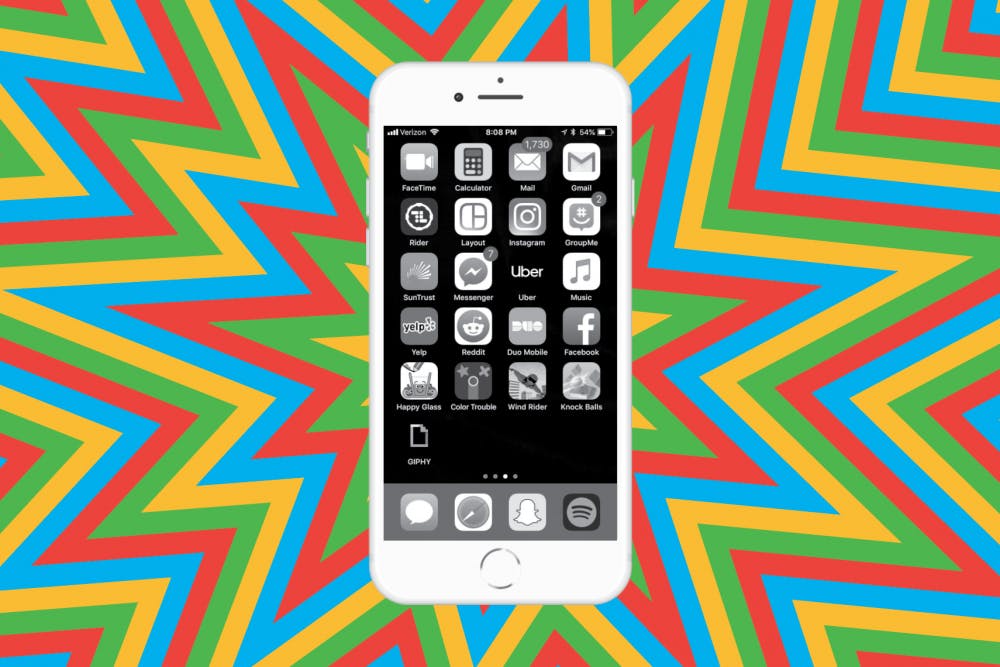Corporations use color to subliminally control your brain, and the only way to resist is by turning your phone on black and white.
Sorry, let me rephrase that to sound less like I’m wearing a tinfoil hat.
Phones are engineered to be addictive. Color is an important tool for designers who want to keep users coming back for more. Any home screen overflows with electric blues, iridescent greens and candy reds — a color palette brighter and more vibrant than just about anything else people regularly look at. This is all purposeful. A specific example — Apple’s email and messages notifications are red. That’s not a coincidence. Stop signs are red, red cars get pulled over more and in the animal kingdom, red often signals poison. Red means urgency and panic. Hence, Apple chose to make their notifications red. Corporations use color to subliminally control your brain.
The solution, as suggested to me by this paper’s Humor writer Zach Schauffler, is to turn your phone on black and white. Switching to grayscale isn’t as easy as you might think — the option is buried deep in Settings, perhaps another indicator that Apple doesn’t want you to free yourself from their rainbow-hued mantle. In any case, I made the switch. My phone has been gray for the last two weeks.
Grayscale curbs addiction in a couple of different ways, aside from just limiting the subterranean effects of bright colors. Some apps are simply less appealing without color. Snapchat is a mess. Most games don’t work nearly as well. Everyone’s Instagram posts look extra artsy and pretentious.
Grayscale is effective in subtler ways as well. The change creates a small barrier between phone-world and the real world. Now, when I look up after staring at my phone for 20 minutes, I am momentarily surprised to be flung back into a world of vibrant color. It’s easier to recognize the amount of time I’m spending looking at a screen now that my phone can’t mimic the real world as effectively. Clearly delineating the phone-world and the real world is a key technique for self-regulation. Grayscale helps draw those lines.
Of course, some apps aren’t affected by the color shift. Grayscale has done nothing to cure me of my Twitter addiction. Reddit and Twitter remain distracting and engrossing for their infinite ability to provide new content. These apps aren’t addictive because they look pretty but rather because they promise that each refresh will bring something novel and exciting. Black-and-white slot machines are still slot machines.
I’ve spoken about my little experiment with lots of people over the last two weeks. After just a few sentences of initial explaining, almost everyone I’ve spoken to has asked — without my suggesting — how to switch their device to gray. I have unintentionally started a small-scale gray wave amongst my friends. Some have abandoned the technique faster than others, but nearly everyone has been eager to try.
In a vacuum, the paradox would be startling. People pay hundreds of dollars for the most powerful and amazing devices ever created and then immediately look for ways to make those devices worse. But nowadays, it shouldn’t be surprising that people are eager to find little ways to push back against the digital era’s hurtling progress. Other programs have been developed towards the same end. Google Chrome plugin StayFocusd allows users to pre-block time-wasting websites on their own computers. The app Moment tracks screen time, promising to help users “Unplug. Use your phone less.”
Grayscale has likely slightly lowered my phone usage, but it hasn’t fundamentally altered the way I interact with the technology. Like most students I still live and breathe through my phone.
Instead, two weeks of grayscale has been an opportunity to examine how I, one person, choose to interact with the massive cultural shifts that make up modern life. Apple CEO Tim Cook is not losing any sleep over my decision to switch to gray. I’ll probably keep refreshing Twitter until my eyeballs melt. Switching my phone to gray is like throwing a pebble in the ocean.
Small resistances are important, though, because they keep us vigilant. How can I retain autonomy when I’m reliant on a device designed to manipulate me? How can I balance the real downsides and the phenomenal thrills of life in the digital age? A little thing — two weeks of black-and-white Snapchat — raised these big questions. As I’ve found in my conversations with friends in the past days, other people are eager to engage with these questions, too.
I don’t know how long I’ll stick with grayscale. I suspect that soon I’ll be lured back to the world of Candy Crush and colorful Instagram posts. The corporate overlords will break me down with their bright and delectable hues. But next time I feel like my phone is running my life, maybe I’ll go back to gray for a few days, go back to a world where everyone’s Instagrams look like Man Ray and where I have, at least, the illusion of control.
Ben Hitchcock is a Life Columnist for The Cavalier Daily. He can be reached at life@cavalierdaily.com.







